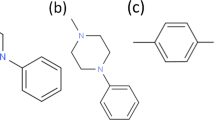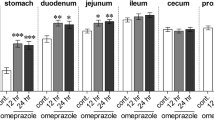Summary
Olsalazine (azodisalicylate) and mesalazine (5-aminosalicylic acid) have recently been developed as new treatment modalities for inflammatory bowel disease to avoid sulfasalazine-related side effects. However, there are reports regarding new and hitherto unexpected side effects in some patients receiving olsalazine or mesalazine, such as watery diarrhea. Since sodium pump activities play an important role in the pathogenesis of water and electrolyte disturbances, we investigated the influence of olsalazine and mesalazine on human ileal and colonic (Na+ + K+)-ATPase and its specific [3H]-ouabain binding. We found a concentration-dependent inhibition of ileal and colonic (Na+ + K+)-ATPase by olsalazine with an IC50 of 4.1 mM and 4.8 mM, respectively. Mesalazine inhibited this enzyme in the ileum with an IC50 of 4.5 mM and in the sigmoid colon with an IC50 3.5 mM. In addition, [3H]-ouabain binding was inhibited by mesalazine with an IC50 of 3.6 mM. The maximal inhibition, however, did not exceed 80% under any conditions (up to 10 mM drug concentration). Olsalazine and mesalazine induce inhibition of the ileal and colonic sodium pump activities that may (in addition to other possible mechanisms) mediate impaired water and electrolyte absorption. This is possibly of clinical relevance in patients with severely damaged mucosa. In patients with milder forms of mucosal inflammation, this inhibition most likely is of minor importance because of the great capacitiy of the (Na+ + K+)-ATPase and the incomplete inhibition leaving at least 20% of the enzyme activity intact.
Similar content being viewed by others
Abbreviations
- 5-ASA:
-
5-aminosalicylic acid
- EDTA:
-
ethylenediaminetetracetic acid
- IBD:
-
inflammatory bowel disease
References
1.Allgayer H (1992) Sulfasalazine and 5-ASA compounds. Gastroenterol Clin North Am 21:643–658
Allgayer H, Brown L, Kruis W, Erdmann E, Paumgartner G (1986) Inhibition of human colonic (Na+ + K+)-ATPase by arachidonic and linoleic acid. Naunyn Schmiedebergs Arch Pharmacol 332:398–402
Allgayer H, Brown L, Kruis W, Paumgartner G, Erdmann E, Wiebecke B (1988) Inverse relationship between colonic (Na+ + K+)-ATPase activity and the degree of mucosal inflammation in inflammatory bowel disease. Dig Dis Sci 33:417–422
Austin CA, Cann PA, Jones TH, Holdsworth CD (1984) Exacerbation of diarrhea and pain in patients treated with 5-amino salicyclic acid for ulcerative colitis. Lancet I:917–918
Chakraborthy TK, Bhatia D, Heading RC, Ford MJ (1987) Salicylate induced exacerbation of ulcerative colitis. Gut 28:613–615
Eiderhamin J, Finkel Y, Starndvik B (1989) Na,K-ATPase activity in rectal mucosa of children with ulcerative colitis and Crohn's disease. Scand J Gastroenterol 24:1121–1125
Evans DF, Pye G, Bramley T, Clark AG, Dyson TJ, Hardcastle JD (1988) Measurement of gastrointestinal pH profiles in normal ambulant human subjects. Gut 29:1035–1041
Goerg KJ, Wanitschke K, Gabbert H, Breiling J, Frank M, Meyer zum Büschenfelde KH (1987) Azodisalicylate (azodisal sodium) causes intestinal secretion. Digestion 37:79–87
Jarnerot G (1989) Newer 5-aminosalicylic acid based drugs in chronic inflammatory bowel disease. Drugs 37:73–86
Lauritsen K, Laursen LS, Burkhave K, Rask-Madsen J (1988) Colonic prostaglandin E2 levels and olsalazine metabolism in relapsing ulcerative colitis: implications for controlled trials in the long term. Scand J Gastroenterol 23 [Suppl 148]:76–80
Lauritsen K, Laursen LS, Rask-Madsen J (1990) Clinical pharmacokinetics of drugs used in the treatment of gastrointestinal disease. II. Clin Pharmacokinet 19:94–125
Laursen LS, Stokholm M, Burkhave K, Rask-Madsen J, Lauritsen K (1990) Disposition of 5-aminosalicylic acid by olsalazine and three mesalazine preparations in patients with ulcerative colitis: comparison of intraluminal colonic concentrations, serum values, and urinary excretion. Gut 31:1271–1276
Lowry OH, Rosebrough NJ, Farr AC, Randall RJ (1951) Protein measurement with the Folin phenol reagent. J Biol Chem 93:265–275
Mohsen AQM, Mulvey D, Priddle JD, Parsons DS, Jewell DP (1987) Effects of olsalazine in the jejunum of the rat. Gut 28:346–352
Mulder CL, Tytgat GN, Weterman IT, Dekker W, Blok P, Schrijver M, van der Heide H (1988) Double-blind comparison of slow-release 5-ASA and sulfasalazine in remission maintenance in ulcerative colitis. Gastroenterology 95:1449–1453
Rachmilewitz D, Treves AJ, Ligumski M, Sharon P, Zifroni H, Karmeli F (1982) Possible role of prostanoids as mediators in the pathogenesis of inflammatory bowel disease. In: Rachmilewitz D, Pena A (eds) Inflammatory bowel diseases. Nijhoff, Hague, pp 161–173
Riley SA, Turnberg LA (1990) Sulphasalazine and the aminosalicylates in the treatment of inflammatory bowel disease. Q J Med 75:551–562
Robinson MG (1989) New oral salicylates in the therapy of chronic inflammatory bowel disease. Gastroenterol Clin North Am 18:43–50
Sandberg-Gertzen H, Jarnerot G, Kraaz W (1986) Azodisal sodium in the treatment of ulcerative colitis. A study of tolerance and relapse prevention properties. Gastroenterology 90:1024–1030
Scheurlen C, Wedel S, Zwiebel FM, Kruis W, Allgayer H, Scholz R (1992) Olsalazine related diarrhoea: does rat intestine adapt in vivo? Scand J Gastroenterol 27:311–316
Schoner W, von Ilberg C, Kramer R, Seubert W (1967) On the mechanism of Na+- and K+-stimulated hydrolysis of adenosine triphosphate. I. Purification and properties of a Na+- and K+-activated ATPase from ox brain. Eur J Biochem 1:334–343
Tripp JM, Müller DDR, Harris D Jr (1980) Mucosal (Na+ + K+)-ATPase and adenylate cyclase activities in children with toddler diarrhea and the postenteritis syndrome. Pediatr Res 14:1382–1386
Wadworth AN, Fitton A (1991) Olsalazine: a review of its pharmacodynamic and pharmacokinetic properties, and therapeutic potential in inflammatory bowel disease. Drugs 41:647–664
Wanitschke R, Goerg KJ, Jeschek B, Krok S (1987) The effect of azodisalicylate on net electrolyte and water transfer in the intact healthy human colon. Abstract. Gastroenterology 92:1685
Author information
Authors and Affiliations
Rights and permissions
About this article
Cite this article
Scheurlen, C., Allgayer, H., Kruis, W. et al. Effect of olsalazine and mesalazine on human ileal and colonic (Na+ + K+)-ATPase. Clin Investig 71, 286–289 (1993). https://doi.org/10.1007/BF00184728
Received:
Revised:
Accepted:
Issue Date:
DOI: https://doi.org/10.1007/BF00184728




